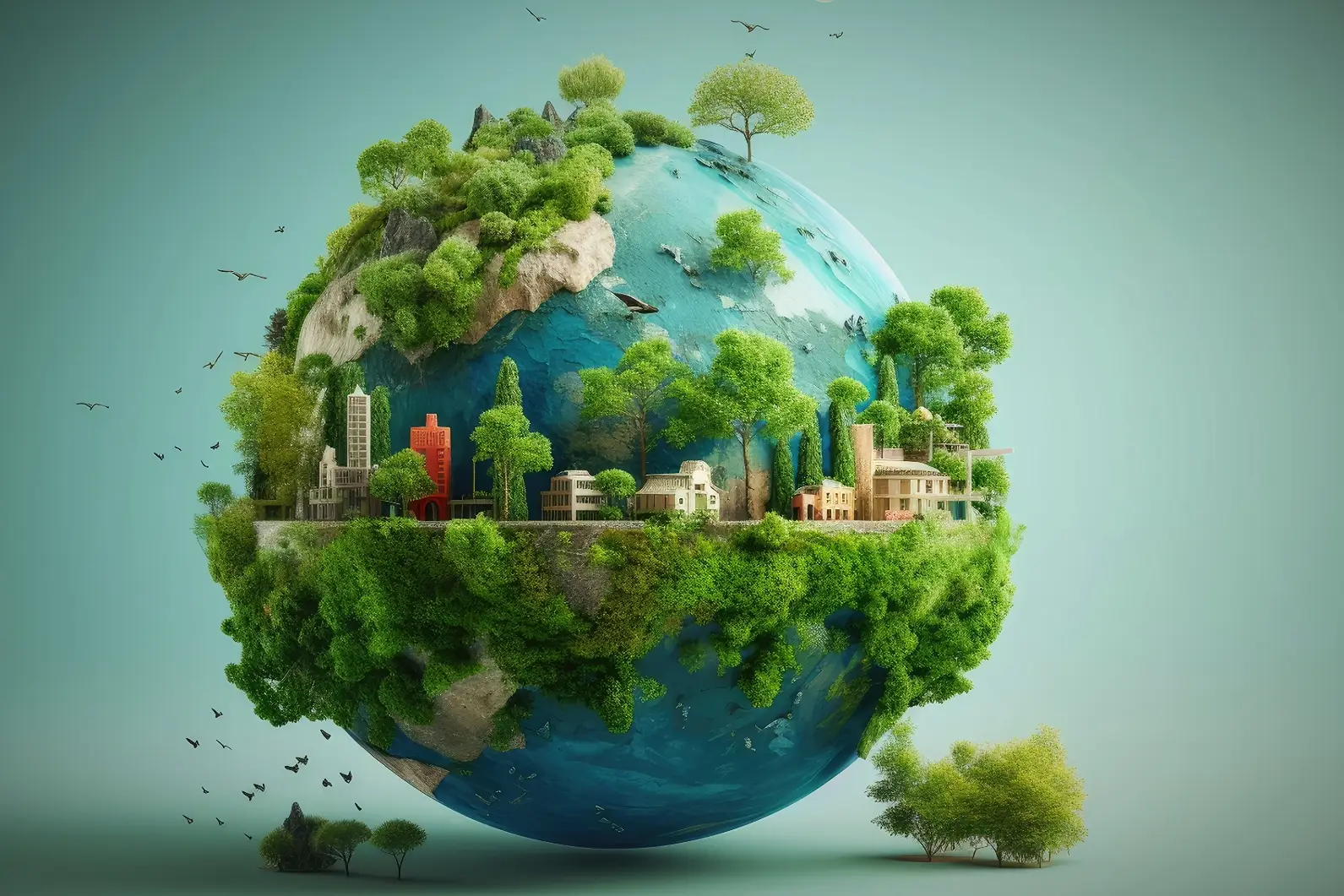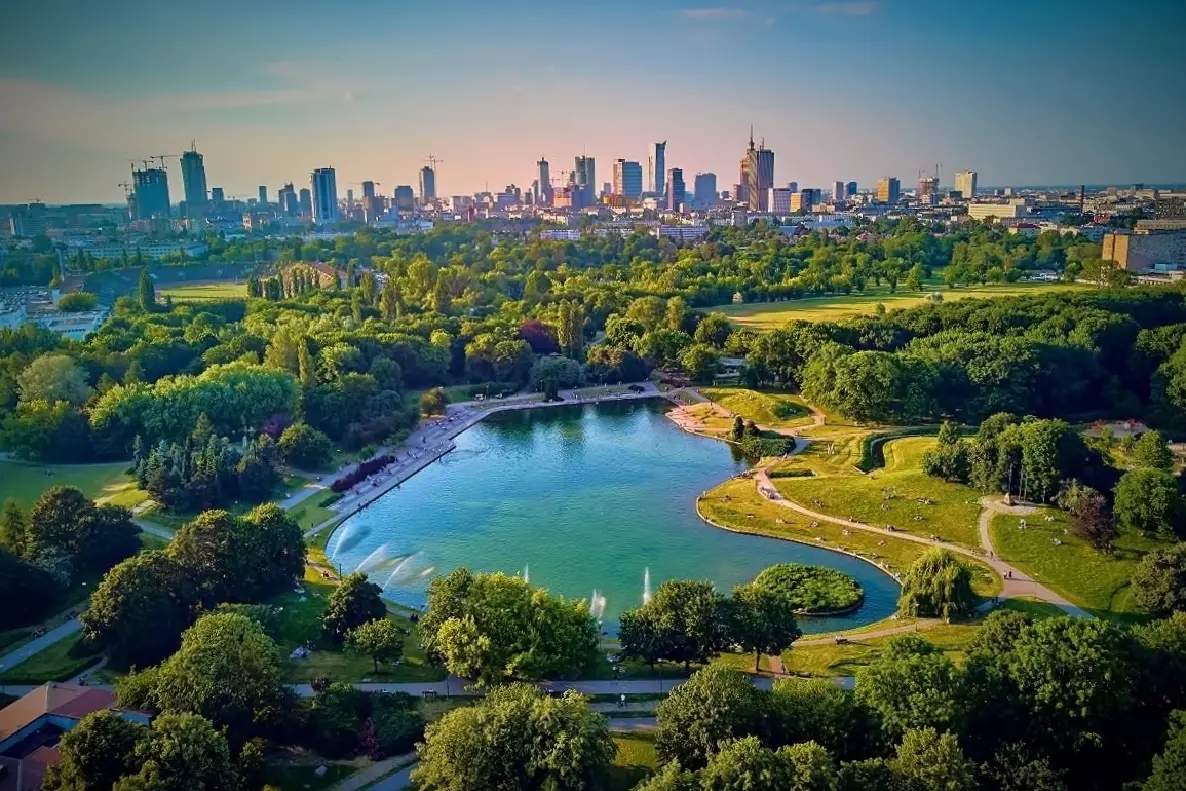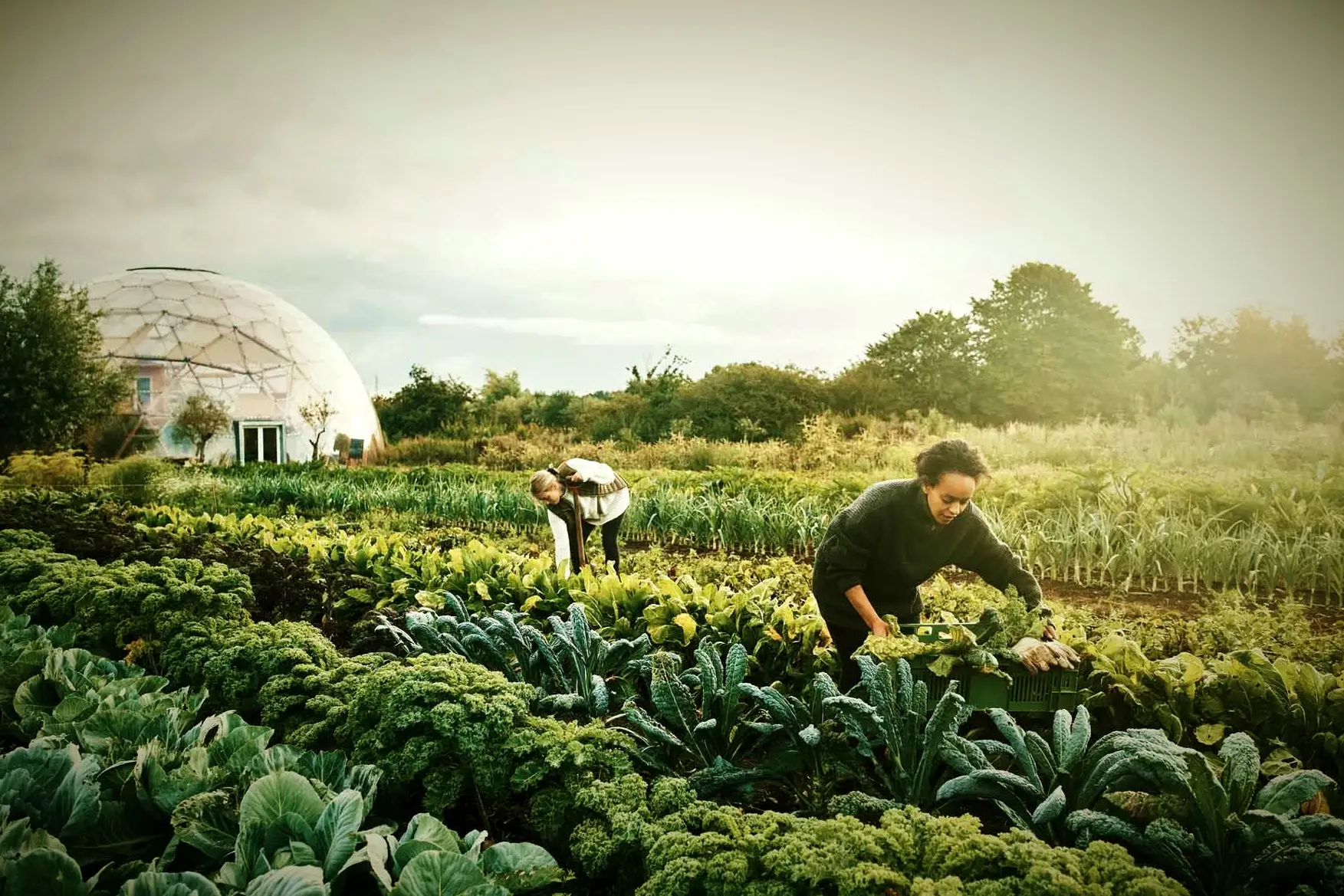Environment
About the Places where we Live, Work and Play
It turns out “location, location, location” isn’t just for real estate — it matters for your health, too…





The World We Live In: Healthy Environments, Healthy People
This is the newest main section of the Eat.Play.Live website, joining its three companions: Nutrition (Eat), Fitness (Play), and Lifestyle (Live).
At first, I considered grouping environmental factors under the Lifestyle heading. After all, where we live and how we live are closely connected. But the many ways our surroundings can influence health and well-being are complex and deserve their own space. Environment covers both the natural world (air, water, soil, ecosystems) and the man-made settings (homes, workplaces, cities) where we spend our time. And just like diet or exercise, the “health” of these environments can have a major effect on our own health and well-being – sometimes in subtle, positive ways, and sometimes in more concerning ones.
This page – and the blog posts associated with it – will explore those connections in a clear and practical way, with the same approachable style as the rest of Eat.Play.Live. The goal is to help you understand how your surroundings influence your well-being, and what steps you can take to embrace what’s good for your health – and avoid or change what is not.
Environmental factors play a crucial role in our overall health and well-being, touching both body and mind. A healthy environment gives us the basics we need to thrive: clean air, safe drinking water, nutritious food, secure living spaces, “green” spaces (and the sunlight that comes with them), good sanitation and hygiene – plus opportunities for physical activity and social interaction. On the flip side, polluted or unsafe environments can chip away at our health and well-being, sometimes in obvious ways (like respiratory illness) and sometimes more quietly, through stress or chronic conditions. According to the World Health Organization (WHO), a healthier environment could prevent nearly a quarter of the global disease burden – a staggering reminder of how much our surroundings really matter.
The Hidden Side of Health: “It’s not Just You – It’s Where You Live Your Life”
The truth is, it’s challenging to pin down exactly which environmental factors are responsible for causing a particular health problem, and it’s not just what you’re exposed to that matters, but also how your body responds. Health issues related to the environment are complex and shaped by a mix of influences – including how likely your genes are to develop a disease or condition (scientists call this genetic susceptibility), as well as physical, biological, and socio-economic factors.
The places where you live, work, and spend your time has a powerful effect on your health. For example, clean air, safe drinking water, access to parks or other “green” spaces (and sunlight), and quiet, low-light environments (at night) support good health and well-being. On the other hand, exposure to pollution and harmful substances can take a serious toll on your health. And sometimes the culprits are less obvious, such as:
- Prolonged exposure to noise (noise pollution) can contribute to stress and raised blood pressure.
- Excessive and inappropriate artificial lighting at night (light pollution) can interfere with sleep quality and hormone balance.
- Indoor toxins – like volatile organic compounds (VOCs) from paint, furniture, or cleaning supplies – can have hidden but potentially severe long-term health repercussions.
- Personal care products – Many ingredients in personal care products and cosmetics can cause allergic reactions for some people, and even long-term issues like cancer, reproductive problems, and hormonal imbalances.
Healthy Spaces: Lessons from the “Blue Zones”
Our everyday surroundings – and how we interact with them – are among the biggest influences on our health and well-being. In recent decades, the idea of “blue zones” has drawn attention worldwide. These are geographic regions where people live noticeably longer, healthier lives, with lower rates of chronic diseases.
There are five well-known blue zone communities: Sardinia (Italy), Okinawa (Japan), Nicoya (Costa Rica), Ikaria (Greece), and Loma Linda (United States). What sets them apart isn’t one “secret” but a blend of factors: a clean environment, fresh and wholesome foods, regular moderate physical activity, strong social connections, lower stress levels, and a sense of purpose. In other words, health thrives not only because of where people live but also how they interact with their environment to support daily life.
The Role of Your Physical Environment
Our physical surroundings shape us more than we might realize. Whether you live in a big city or the country, at home with your family or flatting (sharing a house or apartment) with friends, your immediate environment not only influences your health, but also your state of mind. Environments that are calming and aesthetically pleasing can lower stress levels, reduce anxiety, relieve tension, and contribute to a sense of safety and security.
Positive Environmental Influences
A healthy environment is more than just the absence of health hazards. It’s about creating and maintaining conditions that actively support health and well-being, such as:
- Access to clean air and safe drinking water
- Access to affordable, nutritious, whole foods
- Availability of affordable safe, healthy homes
- Workplaces that protect workers from hazards and injuries
- Access to a range of “green” spaces, such as parks and other natural environments
- Stewardship of natural resources and efforts to minimize pollution and environmental degradation
- A supportive social environment that encourages interaction and reduces isolation
Negative Environmental Influences
Unfortunately, not all environments are health-friendly. Human activities such as deforestation, unsustainable farming practices, heavy industrialization, and rapid urbanization often create unhealthy conditions, including:
- Pollution: Air and water contamination, chemical exposures, and noise pollution
- Hazardous substances: Toxins and hazardous materials in everyday environments
- Extreme weather: Climate-related events such as floods, droughts, or heatwaves
- Overcrowding and poor housing conditions: A significant risk factor for the spread of infectious diseases, as well as poorer mental well-being.
- Social isolation: Social barriers like living in a remote rural area or poor public transportation services, contribute to social isolation by limiting people’s ability to access social, recreational, and essential activities and services, which can pose serious physical and mental health risks.
Environmental Toxins: Hidden Hazards all around us
Environmental toxins are substances or organisms in our surroundings that can adversely affect your health. Some occur naturally, but most are linked to human activity – from industrial and agricultural processes, to many of the products we use in daily life. Some environmental toxins can even be biological in origin.
Environmental toxins lurk both outdoors and indoors – outdoors, the risks come from air pollutants (like particulates and vehicle exhaust) and contaminants in water or soil; while indoors, toxins are released by certain building materials and cleaning supplies, and human activities like smoking, and even cooking. In fact, indoor air is often more polluted than outdoor air – a big concern since most of us spend the majority of our time inside.
To complicate matters, many products that we use daily in and around the house such as household cleaners, pesticides, fuel oil (gasoline), plastics, cosmetics, and even prescription or over-the-counter drugs can all be toxic under the wrong conditions. The line between “safe” and “harmful” often depends on how much, how often, and in what context we’re exposed.
Where Toxins Come From
Environmental toxins come from three main sources:
Natural Sources
Some toxins are naturally present in the environment. Examples include arsenic in soil, or radon, a radioactive gas released by the breakdown of uranium and radium found in soils and rocks, that can sometimes seep into homes where it can accumulate in poorly ventilated spaces, such as basements. Natural events like volcanic eruptions and wildfires also release toxins into the air. Fortunately, these are usually dispersed and broken down fairly rapidly by natural filtering processes.
Biological Sources
Certain living organisms produce toxins, too. Examples include:
- Bacteria: such as Clostridium botulinum, which produces botulinum toxin
- Moulds and fungi: which can release mycotoxins
- Plants and algae: many plants contain toxic compounds, while algal blooms in oceans and lakes can contaminate shellfish with dangerous toxins
These substances may end up in our food, water, or air, posing risks to both human and animal health.
Man-Made Sources
By far the most common and concerning toxins come from human activity. Industrial, agricultural, and household practices concentrate and release harmful substances into the environment, and often at levels that can cause serious harm. Examples include:
- Air pollution: emissions from factories, vehicles, second-hand smoke, and volatile organic compounds (VOCs) from paints and furnishings
- Water contamination: pesticides, heavy metals that seep into water supplies, and treatment chemicals
- Food contamination: residues of pesticides and other chemicals in the foods we eat
- Household products: everyday items like cleaning supplies, cosmetics, plastics, and building materials (such as asbestos) that may release toxins over time
Types of Environmental Health Risks
Different toxins present different risks and challenges. Here’s a closer look at the most common categories:
Air Pollutants
Air pollution includes a mix of small particles and gases that can invade the lungs and bloodstream, leading to respiratory and other chronic infections, lung cancer, stroke, and heart disease. It comprises both outdoor sources (e.g.: factories, vehicles) and indoor sources (e.g.: tobacco smoke, volatile organic compounds from paints or furnishings). Common pollutants include particulate matter (PM), carbon monoxide, sulfur dioxide, nitrogen oxides, and “ground-level ozone”.
Water Pollutants
Contaminants such as lead, mercury, arsenic, pesticides, herbicides, biological agents, and even microplastics can end up in drinking water and aquatic ecosystems. Health risks range from acute illnesses like gastroenteritis, to long-term health risks, such as cancer and neurological disorders. In fact, around 80% of diseases worldwide are linked to poor water quality. Water pollution also disrupts ecosystems, threatening biodiversity and food chains.
Soil Contaminants
Industrial waste, improper hazardous waste disposal, and agricultural chemicals, such as pesticides and fertilizers, can all degrade soil, contaminate crops, and end up in waterways and oceans. Soil pollution impacts health mainly by reducing crop yields, contributing to food insecurity and rendering food unsafe for consumption. People can be exposed to contaminants through direct contact with contaminated soil, breathing in contaminated dust, or consuming contaminated food and water.
Chemical Pollutants
Over 400 environmental chemicals have been detected in human samples. Chemical exposure can damage organs and systems, such as the liver, kidneys, immune system, nervous system, and reproductive system. Some are especially harmful, with effects ranging from cancer (carcinogenic) to birth defects (teratogenic) and genetic mutations (mutagenic). The toxicity level depends on the pollutant type, and exposure amount and frequency.
Even everyday chemicals – like acrolein, acrylamide, and phthalates found in plastics – can disrupt hormones and elevate the risk of many common diseases, chronic health conditions, and neurological disorders. For example, phthalates has been linked to attention deficit hyperactivity disorder (ADHD) and lower IQ in children. Pregnant women and young children are particularly vulnerable, as fetuses can be exposed to chemicals through the placenta and infants through breastfeeding.
Radiological Hazards
Radiological hazards include naturally occurring and man-made radioactive substances. For example, radon gas, a naturally occurring radioactive gas that comes from the breakdown of uranium in soil and rock, can accumulate in poorly ventilated basements, and is a leading cause of lung cancer. Nuclear waste from industries like mining, nuclear power generation, nuclear weapons programs, and the use of radioisotopes in medical activities, also poses long-lasting health and environmental risks.
How Environmental Toxins Affect Your Health
Environmental toxins are everywhere. While advances in industry and technology have improved our lives in many ways, they’ve also introduced new and widespread health challenges. Globally, environmental toxins affect millions of people each year – with air pollution alone estimated to cause over 5 million deaths worldwide annually.
Some toxins are harmless at very low levels. But as human exposure continues to rise, so do the risks. These substances typically enter the body through inhalation, ingestion, or skin contact. Once inside, they can disrupt biological processes and contribute to health issues ranging from asthma and skin reactions to neurological disorders, cardiovascular problems, and even cancer.
Our bodies are constantly working to filter out toxins through the lymphatic system, liver, and kidneys. But long-term exposure places strain on these organ systems, which can weaken them over time. The effects depend on several factors: the type of toxin, the way it enters the body, how long and how often exposure occurs, and the total dose.
Completely avoiding toxins is nearly impossible – but awareness of their presence and effects can help us make smarter personal choices and encourage stronger public health policies.
What You Can Do to Reduce Exposure
You can’t control every toxin in the world, but you can make small, practical choices every day that add up to a healthier environment – both indoors and out. A good starting point is to get informed about the most common toxins in your surroundings – both at home and at work, and look for ways to reduce exposure where possible.
When it comes to toxins, long-term, repeated exposure is often more harmful than a single one-time contact. That means the products you use most often deserve the closest scrutiny. Check ingredients, read warning labels, and when in doubt, choose the safer option.
You don’t need a complete lifestyle overhaul. A few small changes in daily habits – done consistently – can lighten your toxic load, improve well-being, and create healthier spaces for you and those you love.
Easy Changes You Can Start Today
- Breathe better indoors: Open windows for fresh air when possible; use extraction fans when cooking.
- Drink smarter: If you’re unsure of tap water quality, use a reliable water filter.
- Wash produce: Rinse fruits and vegetables thoroughly to reduce surface pesticides and contaminants.
- Let the sunshine in: Natural light boosts mood and supports vitamin D production.
- Follow warnings on product labels: Many products have hazard labels recommending using gloves or safety goggles.
- Stay informed: Check your local Air Quality Index (AQI) and pollen forecast – plan outdoor activities for “cleaner air” days.
Pick Your Battles – Choose and Use Wisely
There are many things in your environment you cannot control, but you can be selective about the products you buy and bring onto your body.
- Buy safer cleaning products: Look for natural or low-VOC options.
- Ditch the plastics: Use glass or stainless steel food containers, and avoid heating food in plastic.
- Use non-toxic cookware: Swap out non-stick (Teflon/PTFE) pans for stainless steel, cast iron, or ceramic.
- Personal care products: Ask yourself if you really need all those sprays, powders, and perfumes. Many products contain harmful chemicals. Switch to “non-toxic” options that are free from parabens, phthalates, coal tar dyes and synthetic fragrances (“parfum”). Many of these may irritate your skin, disrupt your hormones, or cause cancer with frequent use in the long run.
Long-Term Habits and Home Improvements
For deeper, lasting changes, focus on the bigger environmental picture:
- Clear the air naturally: Ditch the air fresheners, deodorizers, and scented candles. Artificial fragrances are made up of chemicals. Nothing freshens a room like fresh air – open windows or doors.
- Ditch the pesticides: Overexposure and chronic low-level exposures put you and especially young children at risk of a range of health problems, including asthma, learning disabilities, and problems with brain development. Use non-chemical alternatives when possible.
- Humidity Control: Maintain proper indoor humidity levels to prevent mould and dust mite growth.
- Invest in a whole-house ventilation system, a good vacuum cleaner with HEPA filtration, and an air purifier if needed. Don’t forget to replace filters regularly.
- Mind your materials: When renovating, consider low emission building materials and products. Choose carpets, glues, paints, and engineered timber that have low or no VOC emissions. Also opt for water-based finishes and low-VOC paints for walls and furniture to reduce long-term emissions.
- Support sustainability: Reduce, reuse, recycle – every step helps to lower environmental pollution at the source.
Support Your Body’s Detox Systems through Healthy Lifestyle Practices
Your body has an impressive detox system – mainly the liver, kidneys, skin, and lymphatic system. They work best when you take care of them. A healthy diet, regular exercise, good hydration, and limiting alcohol or other toxins all give your liver and kidneys the breathing room they need to do their jobs well.
Sweat It Out
Physical activity improves circulation and lymphatic drainage, helping toxins exit through sweat. Saunas can also support this process by stimulating sweating. Some people use binders like activated charcoal 30–60 minutes before a sauna session to help capture toxins, but this should be approached with care. Always shower after sweating sessions to wash away what’s been released and take care to stay properly hydrated.
Hydration
Drinking enough water supports the kidneys and liver in filtering and removing toxins efficiently.
A Fibre-Rich Diet
A diet rich in fibre and antioxidants supports healthy digestion, which is crucial for eliminating toxins through the bowels.
Supplement Support
Some supplements may help support detoxification pathways:
- Glutathione: A powerful antioxidant that helps the liver neutralizes toxins.
- N-Acetyl Cysteine (NAC): Supports glutathione production.
- Milk Thistle: Traditionally used for liver support.
- Chlorella: Single-celled, green freshwater algae that is rich in nutrients and often used as a dietary supplement or functional food – binds to heavy metals and support their elimination from the body.
(Note: Supplements can be helpful, but they aren’t a substitute for healthy lifestyle habits — and it’s best to check with a healthcare professional before starting new ones.)
At the end of the day, our health and our environment are two sides of the same coin. We thrive when our surroundings support us – with clean air, safe water, nourishing food, and spaces that bring connection and calm. By making mindful choices in our homes, neighbourhoods, and communities, we not only lighten our own toxic load but also contribute to a healthier world for future generations. A little awareness and a few consistent habits can make a big difference – because living well is about more than you, it’s about the world we live in together.
